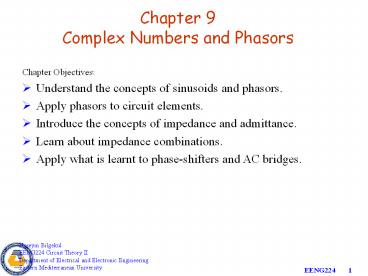Chapter 9 Complex Numbers and Phasors PowerPoint PPT Presentation
1 / 19
Title: Chapter 9 Complex Numbers and Phasors
1
Chapter 9Complex Numbers and Phasors
- Chapter Objectives
- Understand the concepts of sinusoids and phasors.
- Apply phasors to circuit elements.
- Introduce the concepts of impedance and
admittance. - Learn about impedance combinations.
- Apply what is learnt to phase-shifters and AC
bridges.
Huseyin BilgekulEENG224 Circuit Theory
IIDepartment of Electrical and Electronic
EngineeringEastern Mediterranean University
2
Complex Numbers
- A complex number may be written in RECTANGULAR
FORM as
- A second way of representing the complex number
is by specifying the MAGNITUDE and r and the
ANGLE ? in POLAR form.
- The third way of representing the complex number
is the EXPONENTIAL form.
- x is the REAL part.
- y is the IMAGINARY part.
- r is the MAGNITUDE.
- f is the ANGLE.
3
Complex Numbers
- A complex number may be written in RECTANGULAR
FORM as forms.
4
Complex Number Conversions
- We need to convert COMPLEX numbers from one form
to the other form.
5
Mathematical Operations of Complex Numbers
- Mathematical operations on complex numbers may
require conversions from one form to other form.
6
(No Transcript)
7
Phasors
- A phasor is a complex number that represents the
amplitude and phase of a sinusoid. - Phasor is the mathematical equivalent of a
sinusoid with time variable dropped. - Phasor representation is based on Eulers
identity. - Given a sinusoid v(t)Vmcos(?tf).
8
Phasors
- Given the sinusoids i(t)Imcos(?tfI) and
v(t)Vmcos(?t fV) we can obtain the phasor forms
as
9
Phasors
- Amplitude and phase difference are two principal
concerns in the study of voltage and current
sinusoids. - Phasor will be defined from the cosine function
in all our proceeding study. If a voltage or
current expression is in the form of a sine, it
will be changed to a cosine by subtracting from
the phase.
- Example
- Transform the following sinusoids to phasors
- i 6cos(50t 40o) A
- v 4sin(30t 50o) V
Solution a. I A b. Since
sin(A) cos(A90o) v(t) 4cos
(30t50o90o) 4cos(30t140o) V Transform
to phasor gt V V
10
Phasors
- Example 5
- Transform the sinusoids corresponding to
phasors - a)
- b)
11
Phasor as Rotating Vectors
12
Phasor Diagrams
- The SINOR
- Rotates on a circle of radius Vm at an
angular velocity of ? in the counterclockwise
direction
13
Phasor Diagrams
14
Time Domain Versus Phasor Domain
15
Differentiation and Integration in Phasor Domain
- Differentiating a sinusoid is equivalent to
multiplying its corresponding phasor by j?.
- Integrating a sinusoid is equivalent to
dividing its corresponding phasor by j?.
16
Adding Phasors Graphically
- Adding sinusoids of the same frequency is
equivalent to adding their corresponding phasors. - VV1V2
17
(No Transcript)
18
(No Transcript)
19
Solving AC Circuits
- We can derive the differential equations for the
following circuit in order to solve for vo(t) in
phase domain Vo.
- However, the derivation may sometimes be very
tedious.
Is there any quicker and more systematic methods
to do it?
- Instead of first deriving the differential
equation and then transforming it into phasor to
solve for Vo, we can transform all the RLC
components into phasor first, then apply the KCL
laws and other theorems to set up a phasor
equation involving Vo directly.

